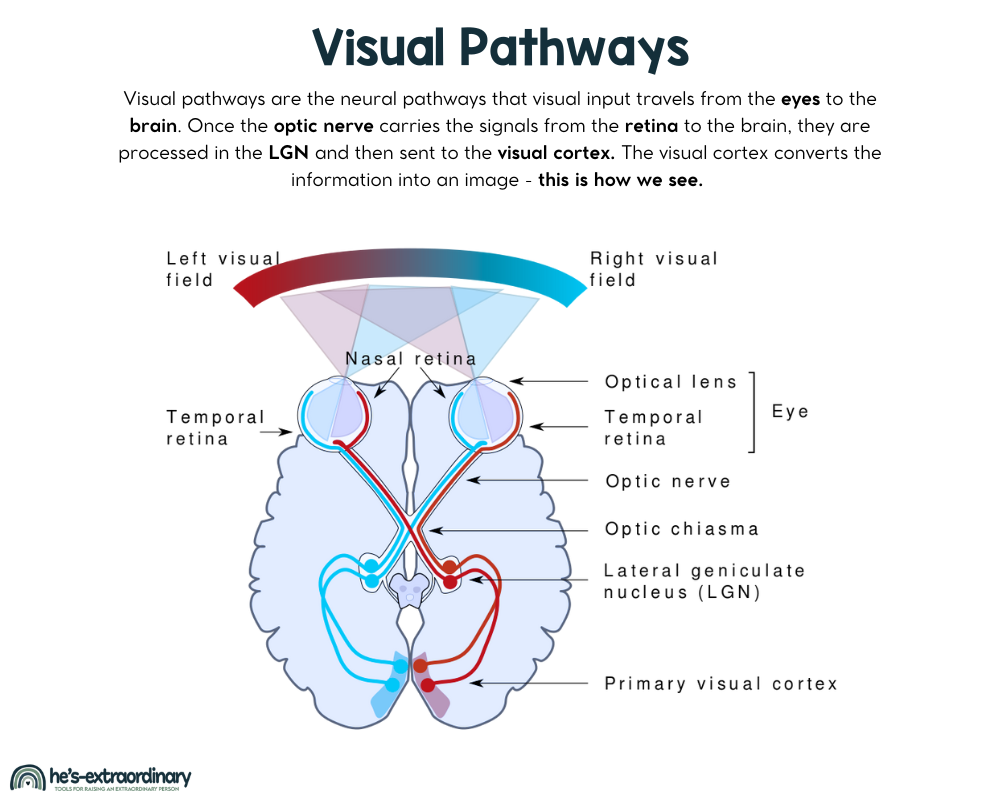How Visual Sensory Processing Works + Strategies for Sensory Seekers and Avoiders
What’s inside this article: A look at how the visual system, our sense of vision, works, signs of sensory processing challenges related to the sensory system in children, and a list of useful strategies for both sensory seekers and avoiders.
Disclaimer: This post contains affiliate links.
This post is part of a 10-part series on the sensory systems. Each part will contain a table of contents to help you easily navigate through the entire series.
Table of Contents:
- Introduction – The Sensory Spectrum
- The Tactile System
- The Auditory System
- The Visual System
- Proprioception
- Vestibular System
- Interoception
- The Olfactory System
- The Oral-Motor System
- Bilateral Coordination
The Visual System
The visual system is the sensory system that allows us to see and process visual information.
The visual system is not just about seeing but about understanding and interpreting the visual world. It’s capable of processing vast amounts of information almost instantaneously, allowing us to react to our environment, navigate space, recognize patterns and faces, and perform countless other tasks that are essential for daily life.
Here’s an overview of the main components and how they work together:
Eyes
The eyes are the primary organs of the visual system. They capture light and convert it into electrochemical signals.
The key parts of the eye involved in this process include:
- Cornea: The clear, dome-shaped surface that covers the front of the eye and helps to focus incoming light.
- Pupil: The opening in the center of the iris that regulates the amount of light entering the eye.
- Iris: The colored part of the eye that controls the size of the pupil.
- Lens: Located behind the pupil, the lens focuses light onto the retina.
- Retina: The layer of cells at the back of the eye that are sensitive to light. The retina contains photoreceptor cells (rods and cones) that convert light into neural signals.
Optic Nerve
The optic nerve is located at the back of the eye, directly opposite the pupil and iris. It’s a bundle of more than a million nerve fibers that connect the retina to the brain.
The photoreceptor cells in the retina (rods and cones) convert light into electrical signals. These signals are then processed by other cells in the retina and transmitted to the optic nerve.
The optic nerve transmits visual information from the retina to the brain. It connects from the back of the eye to the visual cortex in the occipital lobe. This pathway is responsible for transmitting visual information from the retina to the brain, where it’s interpreted as sight.
Visual Pathways
Visual pathways are the neural pathways that visual input travels from the eyes to the brain.
Once the optic nerve carries the signals to the brain, they are processed in several areas:
- Lateral Geniculate Nucleus (LGN): Located in the thalamus, the LGN is a relay center where visual information is processed and then sent to the visual cortex.
- Visual Cortex: Located in the brain’s occipital lobe, the visual cortex is the primary area responsible for processing visual information. The visual cortex has several distinct regions (V1, V2, V3, etc.) that each process different types of visual information, like color, shape, or movement.
The first cell in the visual pathway is called a photoreceptor. This cell is located in the retina.
Basically,
Each eye sees from a different perspective and transmits a different signal to the brain. The visual cortex converts this information into a single stable image – this is what we see.

Signs of Visual Sensory Processing Challenges
How do you tell if your child is struggling with atypical visual processing?
If your child is showing signs of visual processing issues, you should first determine if it’s a visual processing issue or an issue with their vision.
An optometrist can perform an eye exam to determine if there are any problems with your child’s vision. If vision is poor, then your child’s eyes won’t send accurate information to the brain.
If their vision is okay and there is a visual processing issue, then the eyes are sending accurate information to the brain, but at some point along the visual pathway, that information is not getting analyzed and processed properly.
The following section looks at some warning signs you may notice if your child is struggling with sensory integration problems related to the visual system.
Sensory Integration Problems Related to The Visual System
The following are some of the common signs that your child is struggling with visual processing issues. If these apply to your child, it’s a good idea to seek an evaluation from an occupational therapist and discuss these challenges with their pediatrician.
Occupational therapists, particularly those who specialize in sensory integration therapy, can evaluate a child for sensory processing issues.
They use standardized tests and observation to assess a child’s sensory processing
Sensory Discrimination or Perception Issues
Discrimination and perception issues occur when the brain is struggling to interpret and give meaning to sensory input.
- Struggles to copy words off a whiteboard or from a book
- Avoids or has difficulty with activities that require visual acuity. For example, puzzles, mazes, word searches, etc.
- Reverses letters or words when reading or writing
- Doesn’t notice the difference between similar letters and numbers. Such as confusing a 1 with an l. May also struggle when learning the alphabet.
- Reading level below what is developmentally expected for their age level.
Modulation Issues
Occurs when the brain over- or under-responds to sensory input.
Over-Responsive (Visual Defensiveness/Avoidance)
- Avoids or dislikes bright lights and sunlight
- Covers eyes or squints
- Seems scared of moving objects
- Avoids direct eye contact
- Avoids group movement activities
- Headaches or nausea after continuous visual stimulation. For example, watching TV, using a tablet, a computer, etc.
- Unable to estimate distances
- Misses objects in their path or trips/bumps into things
Under-Responsive (Visual Input Seeking)
- Stares at bright and flickering lights
- Moves or shakes head during reading or writing
- Stares at moving objects. For example, fans, pinwheels, spin tops.
- Looks at items really close up, or to the side out of the corner of their eye
- Enjoys visually stimulating images. For example, patterns, optical illusions, bright colors, etc.
Praxis Issues
Praxis issues are related to planning and executing motor movements that the body has not done before. When it comes to the visual system, praxis problems usually involve issues with hand-eye coordination.
- Cannot catch or kick a ball
- Overflows cup when pouring own drink
- Struggles to trace lines/letters
- Struggles with fine motor activities. For example, when beading – struggles to line a string up with a bead.
Strategies for Managing Visual Sensory Processing Differences
Simple modifications and accommodations can make a significant difference for kids with sensory processing differences.
Additionally, many play-based activities used in sensory integration therapy can be implemented at home and school by parents and teachers.
Here are a few strategies that may be helpful.
For Over-Responsiveness:
- Keep clutter to a minimum.
- Do not create too many visual stimuli in your home. For example, lots of photos on the walls, lots of colors, etc.
- Dim/cover lights
- Work on developing sensory integration with games, such as: rolling a ball back and forth on the floor, tossing a bean bag, matching games, color sorting games
- Give breaks from visual input when needed
- Use guided reading strips
For Under-Responsiveness
- Help keep sensory needs met by providing lots of opportunities for visual stimulation
- Use LED and color-changing lights
- Introduce your child to optical illusions
- Decorate home with mirrors, photos that have colors and patterns, etc.
- Use visually stimulating toys such as Kaleidoscope, View Finder, Spin Tops, Fidget Spinners, etc.
- Play I-Spy games, connect the dots, color, paint, etc.
Visual Discrimination
Being able to distinguish between different shapes is a necessary skill for learning to identify letters and numbers. The formation of each letter, or its shape, is the main distinguishing factor.
Kids with visual discrimination challenges will distinguish between objects based on their color rather than their shape. This doesn’t work with letters or numbers.
One way to practice discriminating between objects based on their shape is with shadow matching activities. You can find free printable shadow matching activities here.
Occupational Therapy
An occupational therapist with experience in sensory-integration therapy can address visual processing issues.
They can recommend activities and accommodations to address your child’s specific sensory needs. They may also recommend adaptive equipment or assistive technology to support your child.
Understanding and supporting your child with visual sensory processing challenges is key.
Recognizing the signs early and implementing strategies can substantially aid their ability to navigate the world around them. Whether it’s adjusting their environment, seeking professional guidance, or simply being patient and empathetic, each step can make a world of difference.
Remember, every child is unique, so it’s important to take an individualized approach to helping them with their specific sensory needs.

